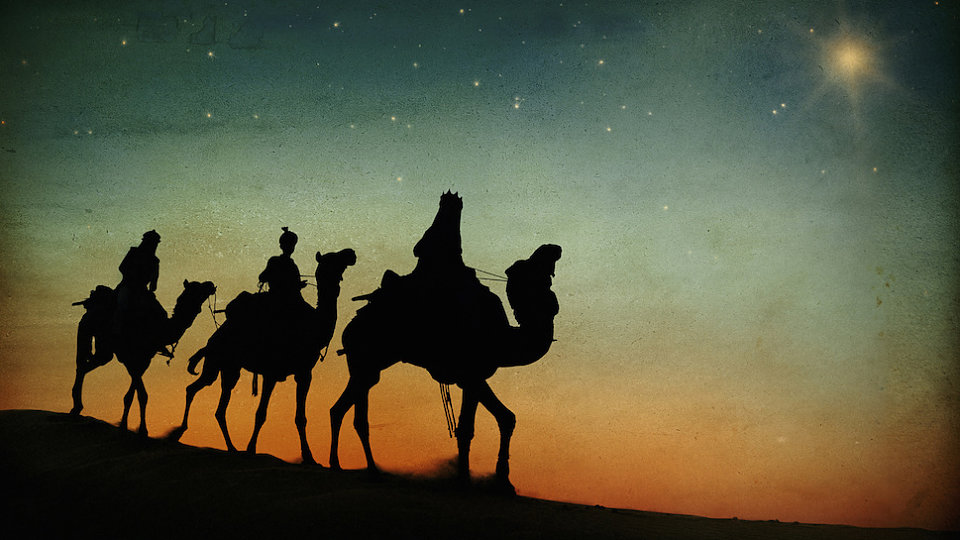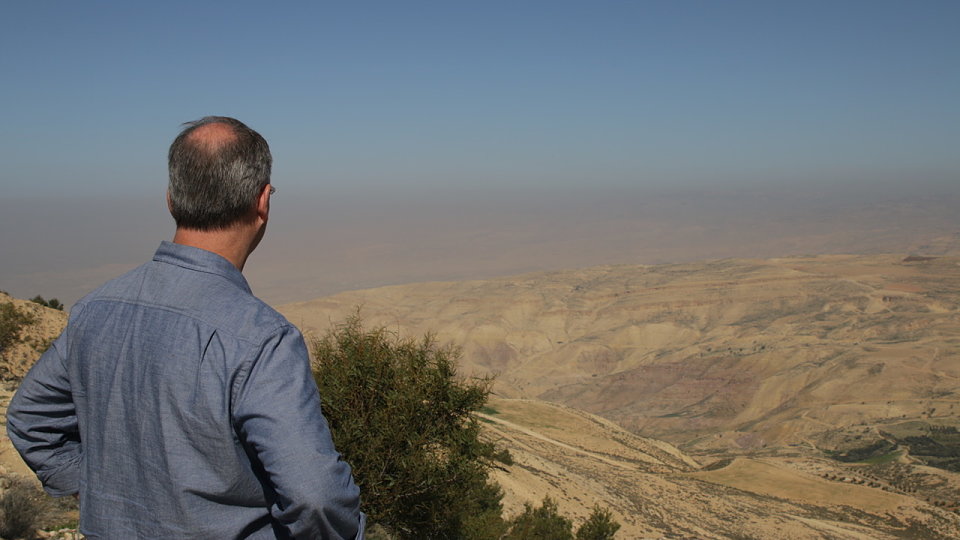Today’s post is an excerpt from Chapter Four of my latest book, Moses: In the Footsteps of the Reluctant Prophet. Click here to read last week’s post, which was taken from Chapter Three. About the photos above: (1) The Plain of el-Raha as seen from St. Catherine’s Monastery. You can imagine thousands of tents in the plain between the mountains. (2) This was snapped by one of our videographers as I was stopped, reading the story of Moses ascending Mt. Sinai to receive the Ten Commandments. Mt. Sinai rises in the background above me. Following God’s dramatic victory over the Egyptian army at the Reed Sea, the Israelites sang, worshiped, and feasted as they celebrated their newfound freedom. Then they followed Moses as he began the journey back to Mount Sinai where he had first encountered God. They would take three months to make the 190-mile journey, and once there they would remain camped at Sinai for the next eleven months. During those eleven months Moses would repeatedly climb Mount Sinai, and God would descend upon the mountaintop to meet him, often in dramatic fashion with smoke, thunder, and lightning. At these meetings God and Moses conversed “face-to-face, like two people talking to each other” (Exodus 33:11). Moses would then bring down from the mountain God’s commands for the people, including the ordering of their religious and civil life. Mount Sinai is the setting for Exodus 19–40, all of Leviticus, and Numbers 1–10. In these passages Mount Sinai is referred to in various ways, including Mount Horeb (though in a handful of places this name seems to refer to a separate mountain) and often simply “the mountain of God” (NRSV). A large valley at the base of Mount Sinai is called the Plain of el-Raha, “the Plain of Rest.” Here the Israelites were said to have camped for nearly a year. It was here, according to tradition, that Moses forty years earlier had met Zipporah, his wife. And it was here, just months before leading the Israelites to this place, that Moses, while grazing his father-in-law’s flock, had heard the voice of God speak to him from the burning bush. Powerful Encounters Towering above the valley are three mountain peaks, but the one that most people climb is referred to by those who live in the region as Jebel Musa—the Mountain of Moses. It is not the tallest of the three peaks, though it is shorter only by a few hundred feet. But it was here, tradition tells us, that God met with Moses and entered into a covenant with the slaves he had just set free. The Lord called to him from the mountain, “This is what you should say to Jacob’s household and declare to the Israelites: You saw what I did to the Egyptians, and how I lifted you up on eagles’ wings and brought you to me. So now, if you faithfully obey me and stay true to my covenant, you will be my most precious possession out of all the peoples, since the whole earth belongs to me. You will be a kingdom of priests for me and a holy nation. These are the words you should say to the Israelites.” (Exodus 19:3-6) This important passage was meant to shape the self-understanding of the Israelite people. It captured God’s purpose in delivering the Israelites and God’s mission for his people. God would enter into a covenant with them, and they with him. He would consider them his most precious possession, and they would become a kingdom of priests who represented God and mediated God’s word, God’s purposes, and God’s grace to the rest of the world. During God’s initial meeting with Moses on Mount Sinai, Moses was told to prepare the people for God’s appearance on the mountaintop. They were to wash their clothes and refrain from sexual intimacy. Moses was to erect a fence before the mountain, telling the people not to touch the mountain. Finally we read in Exodus: When morning dawned on the third day, there was thunder, lightning, and a thick cloud on the mountain, and a very loud blast of a horn. All the people in the camp shook with fear. Moses brought the people out of the camp to meet God, and they took their place at the foot of the mountain. Mount Sinai was all in smoke because the Lord had come down on it with lightning. The smoke went up like the smoke of a hot furnace, while the whole mountain shook violently. The blasts of the horn grew louder and louder. Moses would speak, and God would answer him with thunder. The Lord came down on Mount Sinai to the top of the mountain. The Lord called Moses to come up to the top of the mountain, and Moses went up. (Exodus 19:16-20) The reader of Exodus is meant to feel the awe experienced by the Israelites in these encounters with God. The people were terrified. It was a dangerous thing to be in such proximity to the One by whose power the universe came into existence. I am reminded of the constant refrain in C. S. Lewis’s novels about the land of Narnia regarding its king, the lion named Aslan, who represented Christ: “He is not a tame lion.” Yahweh has compassion, mercy, and love for his people; nevertheless, his power and presence can’t be contained in the tame versions of God that many of us believe in today. We’re meant to take seriously the fear and awe that God inspired as he appeared at Sinai that day. Exodus 20-24 goes on to describe a six-day period when God’s glory covered the top of Mt. Sinai, during which Moses received the Ten Commandments. The Ten Commandments, also known as the Decalogue (the ten words), reflect God’s basic ordering of Israelite society. Of the 613 laws said to have been given by God to Moses, only these ten were said to be etched on stone by the finger of God (Exodus 31:18). These stone tablets were placed inside the ark of the covenant. They represent the foundation of biblical ethics and the summation of the Law. As I sat on the side of Mount Sinai, looking up at the summit as the sun rose, I took out my Bible and read the Ten Commandments, reflecting upon these pivotal commandments. It’s worth noting that most of us don’t like rules. We don’t like people telling us “thou shalt not,” nor even “thou shalt.” Some see the Ten Commandments in this way – a kind of stifling set of commands. But I see them differently. The commandments then, as now, function as theological statements, a vision for human living, and as moral and emotional “guard rails.” As theological statements each tells us something about God, and God’s will for humanity. They offer a vision for how we live, love and relate to one another. And they help us to know the boundaries as we seek to live our lives. They functioned in this way for the ancient Israelites, and they continue to function this way for us today. Far from stifling us, they are meant to keep us from harm, and from succumbing to thoughts and behaviors that enslave. They made it to the “top ten list” – because they address some of the key temptations or tendencies with which human beings wrestle. Here are the Ten Commandments God was said to have etched in the stone tablets, I am the Lord your God who brought you out of Egypt, out of the house of slavery. You must have no other gods before me. Do not make an idol for yourself…Do not bow down to them or worship them. Do not use the Lord your God's name as if it were of no significance; the Lord won't forgive anyone who uses his name that way. Remember the Sabbath day and treat it as holy. Six days you may work and do all your tasks, but the seventh day is a Sabbath to the Lord your God… Honor your father and your mother so that your life will be long on the fertile land that the Lord your God is giving you. Do not kill. Do not commit adultery. Do not steal. Do not testify falsely against your neighbor. Do not desire your neighbor's house. Do not desire and try to take your neighbor's wife, male or female servant, ox, donkey, or anything else that belongs to your neighbor. Exodus 20:2-17 Today’s post is an excerpt from Chapter Four, “The Ten Commandments,” from my latest book, Moses: In the Footsteps of the Reluctant Prophet. Click here to find more information about all Moses products, including the primary book, a Leader Guide, a Children's Leader Guide, and a Youth Study book.








